HONEY ISLAND SWAMP: MOTHER NATURE’S VOODOO
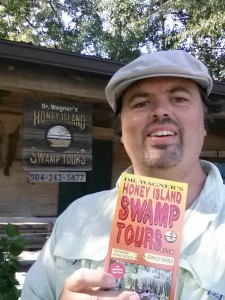 If you look to the right as you cross the Louisiana border on I-10 West from Mississippi you’ll spy miles and miles of unspoiled wetland dubbed Honey Island Swamp by European interlopers who observed the 5×20 mile island at its center completely swarming with honey bees. Still filled with alligators and a few black bear, this dark, receding Cypress swamp is at the same time inviting and foreboding, much like nature’s version of voodoo. No wonder its mystique is burrowed deeply in local lore. This was a filming site for Oscar nominated Beasts of the Southern Wild, a popular spot for the growing number of highly rational ‘reality TV’ inspired Sasquatch hunters, namesake for one of my favorite local bands—Honey Island Swamp Band, and a popular recreational escape for nature-loving locals and New Orleans Tourists seeking pause from the never-ending party on Bourbon Street.
If you look to the right as you cross the Louisiana border on I-10 West from Mississippi you’ll spy miles and miles of unspoiled wetland dubbed Honey Island Swamp by European interlopers who observed the 5×20 mile island at its center completely swarming with honey bees. Still filled with alligators and a few black bear, this dark, receding Cypress swamp is at the same time inviting and foreboding, much like nature’s version of voodoo. No wonder its mystique is burrowed deeply in local lore. This was a filming site for Oscar nominated Beasts of the Southern Wild, a popular spot for the growing number of highly rational ‘reality TV’ inspired Sasquatch hunters, namesake for one of my favorite local bands—Honey Island Swamp Band, and a popular recreational escape for nature-loving locals and New Orleans Tourists seeking pause from the never-ending party on Bourbon Street.
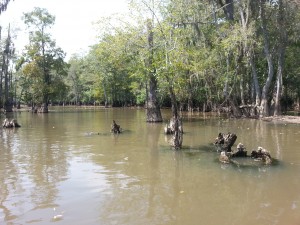 Something about Honey Island Swamp‘s dark waters, tangled Cypress trees, deadly snakes, lush vegetation, and ancient reptilian guardians teases the imagination back to a day when man wasn’t master of his environment, luring us to a simpler but more dangerous time. Thus, as I build my catalogue of popular New Orleans Tourist Attractions, I heeded the Siren’s call and escaped the city on a beautiful early autumn afternoon to lower my blood pressure in the rugged but pristine solitude. (For you can thumb your nose at it all if you have a boat and a knowledgeable guide!)
Something about Honey Island Swamp‘s dark waters, tangled Cypress trees, deadly snakes, lush vegetation, and ancient reptilian guardians teases the imagination back to a day when man wasn’t master of his environment, luring us to a simpler but more dangerous time. Thus, as I build my catalogue of popular New Orleans Tourist Attractions, I heeded the Siren’s call and escaped the city on a beautiful early autumn afternoon to lower my blood pressure in the rugged but pristine solitude. (For you can thumb your nose at it all if you have a boat and a knowledgeable guide!)
ALLIGATOR SHOW & NATURE TUTORIAL
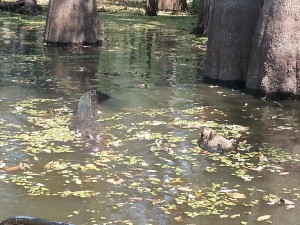 Several local companies offer nature tours, but Honey Island Swamp Tours is the name that’s most often recommended to me, including by Marquis de Metairie whose Godfather worked there before ‘the storm.’ It’s a good hour drive out to Slidell from Uptown but, for a little extra, they’ll pick up tourists from the French Quarter or downtown. It was a nice afternoon for a drive though, and fortunately the experience was well worth the gas expended.
Several local companies offer nature tours, but Honey Island Swamp Tours is the name that’s most often recommended to me, including by Marquis de Metairie whose Godfather worked there before ‘the storm.’ It’s a good hour drive out to Slidell from Uptown but, for a little extra, they’ll pick up tourists from the French Quarter or downtown. It was a nice afternoon for a drive though, and fortunately the experience was well worth the gas expended.
 The ticket and gift shop is located in a little shack not too far off I-10, though a little winding navigation is required so use GPS if possible. I’d been invited to join the 2:00 trip, but they suggested showing up at 1:30. By a quarter till, enough folks had arrived to fill one of the flat-bottomed, canopied boats so our guide, Brian Baldwin, rounded the dozen or so of us up and set off on what turned out to be part nature tutorial, part alligator show.
The ticket and gift shop is located in a little shack not too far off I-10, though a little winding navigation is required so use GPS if possible. I’d been invited to join the 2:00 trip, but they suggested showing up at 1:30. By a quarter till, enough folks had arrived to fill one of the flat-bottomed, canopied boats so our guide, Brian Baldwin, rounded the dozen or so of us up and set off on what turned out to be part nature tutorial, part alligator show.
SWAMP PIMPIN’ AIN’T EASY
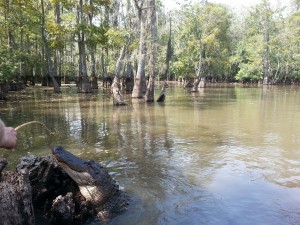 It didn’t take long to penetrate the 10-12” freshwater bayou (derived from a native word for a slow-moving river) and feel immersed in a thick and foreboding Cypress swamp bustling with turtles, Blue Herons, Gray Egrets, and even a White Ibis. Although unseen, Brian assured us the woods were thick with deer, wild boar, and a few black bear. The star attraction, though, was the alligators, still visible in all directions as summer’s heat had yet to dissipate.
It didn’t take long to penetrate the 10-12” freshwater bayou (derived from a native word for a slow-moving river) and feel immersed in a thick and foreboding Cypress swamp bustling with turtles, Blue Herons, Gray Egrets, and even a White Ibis. Although unseen, Brian assured us the woods were thick with deer, wild boar, and a few black bear. The star attraction, though, was the alligators, still visible in all directions as summer’s heat had yet to dissipate.
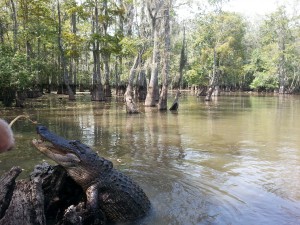 Although these intimidating distant cousins to T-Rex inspire widespread panic, human attacks are rare and deaths practically unheard of. Despite the seemingly hungry looks they cast our way, Brian assures us their diet consists of fish, turtles (crushing through shells with around 2000 lbs of force, second only the crocodile’s 3000 lb chomp), small deer, boars, birds, and, surprisingly, each other. Apparently once the aggressive males reached 10-12” in length they prey almost exclusively on smaller gators. (The females rarely survive this long—I guess chivalry wasn’t even born yet to be dead when these cold-blooded primitives evolved!)
Although these intimidating distant cousins to T-Rex inspire widespread panic, human attacks are rare and deaths practically unheard of. Despite the seemingly hungry looks they cast our way, Brian assures us their diet consists of fish, turtles (crushing through shells with around 2000 lbs of force, second only the crocodile’s 3000 lb chomp), small deer, boars, birds, and, surprisingly, each other. Apparently once the aggressive males reached 10-12” in length they prey almost exclusively on smaller gators. (The females rarely survive this long—I guess chivalry wasn’t even born yet to be dead when these cold-blooded primitives evolved!)
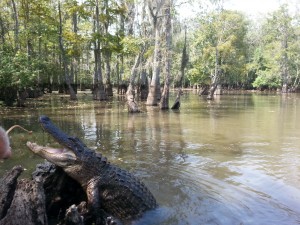 Surprisingly, pimpin’ atop the swamp food chain ain’t easy. Although birds and fish live in peril of becoming gator bait, they also survive by preying on the very beasts that hunt them, devastating entire nests when eggs are located and gobbling up hatchlings before they can grow and return the favor. It’s a true circle of life, though I doubt it feels like a cute Disney show tune when you’re on the menu!
Surprisingly, pimpin’ atop the swamp food chain ain’t easy. Although birds and fish live in peril of becoming gator bait, they also survive by preying on the very beasts that hunt them, devastating entire nests when eggs are located and gobbling up hatchlings before they can grow and return the favor. It’s a true circle of life, though I doubt it feels like a cute Disney show tune when you’re on the menu!
GO AIR JORDAN AND DO THE SEAHORSE
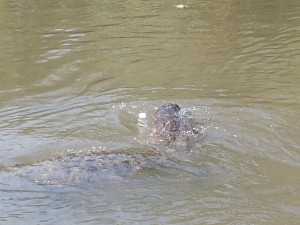 As our guide explained that the tour changes seasonally along with the swamp, he admitted his favorite time of year is the spring when the swamp is in full bloom, followed by late autumn when you get a splash of color and the boar and deer are easier to spot. During the warm months, though, tourists come in droves for the gators and Brian happily delivered.
As our guide explained that the tour changes seasonally along with the swamp, he admitted his favorite time of year is the spring when the swamp is in full bloom, followed by late autumn when you get a splash of color and the boar and deer are easier to spot. During the warm months, though, tourists come in droves for the gators and Brian happily delivered.
Above: Holy Leaping Gators, Batman!
 These waters are protected from state-licensed trappers who are currently active (the season runs late August to the end of September) and these gators have become quite tame, swimming towards the sound of our boat (usually not the desired effect!) We quickly learn why. Brian guided their course by tossing marshmallows in the water like tiny white bobbers, positioning them for captivated visitors to snap pictures. The real photo opportunities, though, began when he baited a stick with chunks of hotdog, prompting his more playful friends (Brian knew them by name) to leap out of the water.
These waters are protected from state-licensed trappers who are currently active (the season runs late August to the end of September) and these gators have become quite tame, swimming towards the sound of our boat (usually not the desired effect!) We quickly learn why. Brian guided their course by tossing marshmallows in the water like tiny white bobbers, positioning them for captivated visitors to snap pictures. The real photo opportunities, though, began when he baited a stick with chunks of hotdog, prompting his more playful friends (Brian knew them by name) to leap out of the water.
Above: As our guide explains gator hibernation, this fellow appears read for a nap!
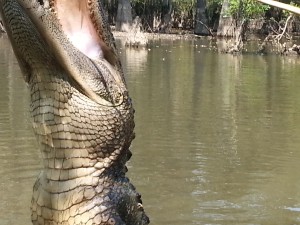 Our first visitor was a twelve-foot monster and I wasn’t prepared as he leapt several feet in the air. My zoom was too tight, so I captured only an incomplete but intimidating snapshot of his neck and jaws. As impressive as the big guys were, though, the small specimens amazed me with their ability to dance on the water’s surface for a split second on the tip of their tails, hopping like giant, green seahorses. While living in Florida I’d been on swamp tours, two different gator preserves, and even did a magazine article following the county’s alligator trapper around, yet I had no idea that these predators could so impressively go Air Jordan!
Our first visitor was a twelve-foot monster and I wasn’t prepared as he leapt several feet in the air. My zoom was too tight, so I captured only an incomplete but intimidating snapshot of his neck and jaws. As impressive as the big guys were, though, the small specimens amazed me with their ability to dance on the water’s surface for a split second on the tip of their tails, hopping like giant, green seahorses. While living in Florida I’d been on swamp tours, two different gator preserves, and even did a magazine article following the county’s alligator trapper around, yet I had no idea that these predators could so impressively go Air Jordan!
FISHING SHACKS OF THE SOUTHERN WILD & TIMID TARAZANS
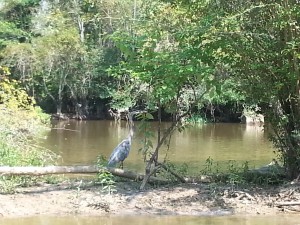 Although leaping gators is good for business our guide was eager to impart his wealth of knowledge about this ecosystem for which he clearly harbored deep love and respect. He pointed out various plants, noting invasive species and telling where they originated and how they’ve altered the natural balance. Pointing out the stumps at the base of Cypress trees, he explained that these weren’t tree stubs but root extensions thrust through the water’s surface to trap floating nutrients.
Although leaping gators is good for business our guide was eager to impart his wealth of knowledge about this ecosystem for which he clearly harbored deep love and respect. He pointed out various plants, noting invasive species and telling where they originated and how they’ve altered the natural balance. Pointing out the stumps at the base of Cypress trees, he explained that these weren’t tree stubs but root extensions thrust through the water’s surface to trap floating nutrients.
 After exploring this secluded back corner, he turned and sped us down wider open bayou as the sun glistened off the water between distant shorelines that were still thick vegetation but could have passed for any river in the south. Stately houses slowly began to disrupt the expanse of green followed by a few fishing cabins. Soon we wandered beyond shores with access roads into a foreign land of shaky river shacks accessible only by boat. This was the site and inspiration for Beasts of the Southern Wild. Many of these structures were abandoned and some remain weekend fishing camps, but a few full-time residents still survive here, working these waters. Per Brian, 30% of the nation’s seafood comes from Louisiana, second only to Alaska, though apparently this has been a rough season for crabs.
After exploring this secluded back corner, he turned and sped us down wider open bayou as the sun glistened off the water between distant shorelines that were still thick vegetation but could have passed for any river in the south. Stately houses slowly began to disrupt the expanse of green followed by a few fishing cabins. Soon we wandered beyond shores with access roads into a foreign land of shaky river shacks accessible only by boat. This was the site and inspiration for Beasts of the Southern Wild. Many of these structures were abandoned and some remain weekend fishing camps, but a few full-time residents still survive here, working these waters. Per Brian, 30% of the nation’s seafood comes from Louisiana, second only to Alaska, though apparently this has been a rough season for crabs.
- Beasts
- of the
- Southern
- Wild!
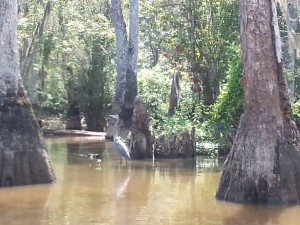 As we trolled the shores unsuccessfully seeking snakes and boars, Brian told a few stories of the deadly water moccasins that infest these waters used by locals for crawfishing, swimming, and skiing. When someone asked about swimming with gators, he shrugged, saying he grew up swimming these waters without incident. As if on cue, we passed a guy swinging out on a rope; however, when everyone cheered him on to let go, he lamely claimed to have a cell phone in his pocket. So, while we failed to spot Sasquatch on the trip (my aunt had requested I go hunting), we did find a timid Tarzan.
As we trolled the shores unsuccessfully seeking snakes and boars, Brian told a few stories of the deadly water moccasins that infest these waters used by locals for crawfishing, swimming, and skiing. When someone asked about swimming with gators, he shrugged, saying he grew up swimming these waters without incident. As if on cue, we passed a guy swinging out on a rope; however, when everyone cheered him on to let go, he lamely claimed to have a cell phone in his pocket. So, while we failed to spot Sasquatch on the trip (my aunt had requested I go hunting), we did find a timid Tarzan.
THE MOST DEADLY ANIMAL
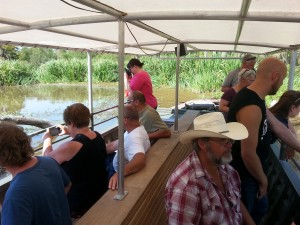 Despite Brian’s dismissal of gator danger, Brian did point out that these could be perilous waters. As usual, though, man is the biggest danger to himself. He related a sad story of an elderly couple who capsized their boat while on a self-guided tour and drowned, as well as of a lady speeding these roads in her new car, failing to realize she had reached the boat ramp and hitting the water doing 60 mph. She was unable to escape.
Despite Brian’s dismissal of gator danger, Brian did point out that these could be perilous waters. As usual, though, man is the biggest danger to himself. He related a sad story of an elderly couple who capsized their boat while on a self-guided tour and drowned, as well as of a lady speeding these roads in her new car, failing to realize she had reached the boat ramp and hitting the water doing 60 mph. She was unable to escape.
WHATEVER PAYS THE BILLS VS WHATEVER FLOATS YOUR BOAT
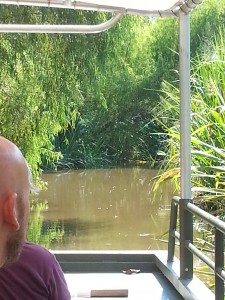 Soon we left the open bayou for the narrow Pearl River that was barely wide enough to admit us. As Brian pointed to the ridges through the trees, he explained this was where gators nested, the temperature of the nest determining gender: Above 93 degrees and they’re male. Below and they’re female. “Proof,” he added “that men are hot-headed and women cold-blooded!” It was a rehearsed but effective jibe. He also, though, proved quit of wit. When we passed a sunken boat, it’s bow sticking up from the water, one passenger asked if that was his last tour. “That’s the competition,” he quickly shot back.
Soon we left the open bayou for the narrow Pearl River that was barely wide enough to admit us. As Brian pointed to the ridges through the trees, he explained this was where gators nested, the temperature of the nest determining gender: Above 93 degrees and they’re male. Below and they’re female. “Proof,” he added “that men are hot-headed and women cold-blooded!” It was a rehearsed but effective jibe. He also, though, proved quit of wit. When we passed a sunken boat, it’s bow sticking up from the water, one passenger asked if that was his last tour. “That’s the competition,” he quickly shot back.
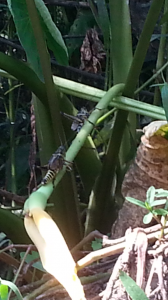 This trip down the narrow Pearl River allowed Brian to show us some of the vegetation up close and he even snatched a few large grasshoppers off a bunch of Sawgrass. Gator tricks may pay the bills, but love of nature clearly floated his boat. The whole tour took about two hours, and it flew by. It was a nice mix of cheesy tourist gator tricks and nature tutorial. I’d love to take the tour again during different times of year. This is beautiful country that provides much-needed respite from the non-stop Mardi Gras of the nation’s most interesting city–even if you’re best friends with The Most Interesting Man In The World, you probably crave hanging out with your blue color friends on occasion for a dose of reality!
This trip down the narrow Pearl River allowed Brian to show us some of the vegetation up close and he even snatched a few large grasshoppers off a bunch of Sawgrass. Gator tricks may pay the bills, but love of nature clearly floated his boat. The whole tour took about two hours, and it flew by. It was a nice mix of cheesy tourist gator tricks and nature tutorial. I’d love to take the tour again during different times of year. This is beautiful country that provides much-needed respite from the non-stop Mardi Gras of the nation’s most interesting city–even if you’re best friends with The Most Interesting Man In The World, you probably crave hanging out with your blue color friends on occasion for a dose of reality!
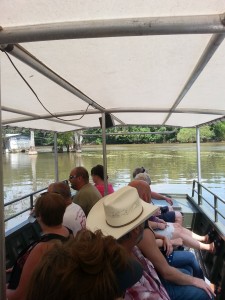 Everyone knows that New Orleans offers fantastic food, music, and parties. Yet there is plenty of variety amongst New Orleans Tourist Attractions, so be sure to round out your visit some history at the National World War II Museum or a dose of nature on a Honey Island Swamp Tour.
Everyone knows that New Orleans offers fantastic food, music, and parties. Yet there is plenty of variety amongst New Orleans Tourist Attractions, so be sure to round out your visit some history at the National World War II Museum or a dose of nature on a Honey Island Swamp Tour.
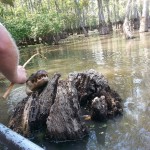
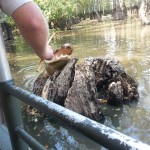
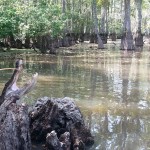
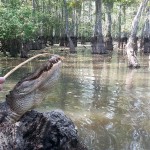
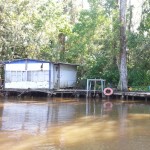
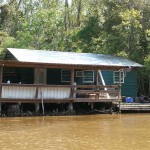
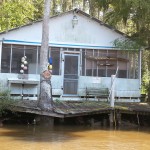
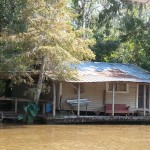
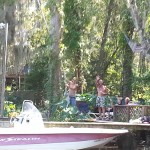
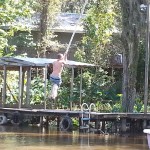
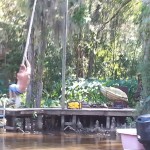
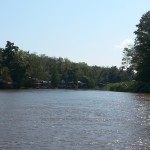
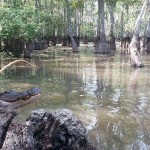
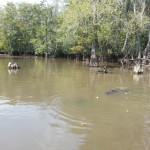
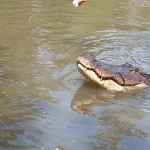
Don’t think I would be brave enough to take the boat ride. Didn’t know alligators ate each other. Enjoyed the history lesson.
We we’re on this specific tour and it was as described.